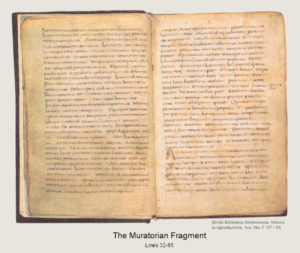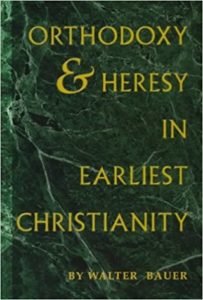2018 New Testament Apocrypha Course: Reflections on Week Two
Last week I began the latest incarnation of my course “The New Testament Apocrypha” (syllabus posted on my parent site HERE). As in previous years, I am posting weekly reflections on each week’s lecture, in part to encourage pedagogical discussion on how to teach this material (and I won’t always do it well), and to provide a forum for my students to offer their thoughts on the course (and thereby gain additional participation marks).
The first class mostly comprised housekeeping: going over the syllabus, providing some background on the New Testament for the benefit of students who have never taken a course in Christianity, and running over some basic concepts (“apocrypha,” “canon,” etc.). The second class, which took place last night, had more substance, so I start this reflections series at week two.
 This second class covered two topics: canon formation and the categories of orthodoxy and heresy. The readings entailed an assortment of canon lists from our primary text collection (Bart Ehrman’s Lost Scriptures) a few chapters from our course textbook (my Secret Scriptures Revealed), and a chapter from Walter Bauer’s Orthodoxy and Heresy in Earliest Christianity.
This second class covered two topics: canon formation and the categories of orthodoxy and heresy. The readings entailed an assortment of canon lists from our primary text collection (Bart Ehrman’s Lost Scriptures) a few chapters from our course textbook (my Secret Scriptures Revealed), and a chapter from Walter Bauer’s Orthodoxy and Heresy in Earliest Christianity.
The class began with reading the Muratorian Fragment as a group. I like to start each class with a discussion of one of the assigned texts; it gets people talking early in the night rather than at the end, when they are starting to get tired (this is a three-hour evening class after all). We went through this canon list slowly and tried to tease some nuances out of it. I think it gave the students some sense of how closely to read the texts and the kind of critical questions to ask of them.
 As mentioned above, we looked also at the Bauer Thesis. Bauer’s book is a beloved piece of scholarship among “liberal” scholars (like Bart Ehrman and me). It argues for an early plurality of thought in the early centuries, with various “heretical” forms of Christianity being dominant (and therefore “orthodox”) in some areas, and only one of these became the dominant form of Christianity in the fourth century and beyond. It is a relativistic look at the development of Christianity that rankles conservative scholars who have worked hard to discredit the book. Some of their concerns are legitimate (discoveries of new texts, like the Nag Hammadi Library, are damaging to some of Bauer’s points), but Bauer’s larger argument remains valid, at least for some areas, particularly Edessa. Unfortunately, students tend to find the text a difficult read—it’s not friendly to beginners—and perhaps next time I will assign some questions to guide their reading (e.g., what is the name given to the orthodox group who came to Syria in the third century?). A few students remarked that my textbook was a far easier and more entertaining read (congratulations on earning an A in the course!).
As mentioned above, we looked also at the Bauer Thesis. Bauer’s book is a beloved piece of scholarship among “liberal” scholars (like Bart Ehrman and me). It argues for an early plurality of thought in the early centuries, with various “heretical” forms of Christianity being dominant (and therefore “orthodox”) in some areas, and only one of these became the dominant form of Christianity in the fourth century and beyond. It is a relativistic look at the development of Christianity that rankles conservative scholars who have worked hard to discredit the book. Some of their concerns are legitimate (discoveries of new texts, like the Nag Hammadi Library, are damaging to some of Bauer’s points), but Bauer’s larger argument remains valid, at least for some areas, particularly Edessa. Unfortunately, students tend to find the text a difficult read—it’s not friendly to beginners—and perhaps next time I will assign some questions to guide their reading (e.g., what is the name given to the orthodox group who came to Syria in the third century?). A few students remarked that my textbook was a far easier and more entertaining read (congratulations on earning an A in the course!).
We finished the class with an exercise that I tried a few times in previous incarnations of the course. It was created by Bryan Whitfield and is found in Roncare and Gray’s Teaching the Bible volume (from SBL). The exercise asks the students to choose the three most significant movies they have seen. They then partner with another student and the two of them must reach a consensus on the significance of four of their six choices. Then they join another group and pick six from the eight, and finally they merge into groups of eight and pick five (we had to modify this slightly for the number of students in the class). When finished we discussed the process by which they reached that consensus and link this to canon formation. I think the students enjoyed the process; it certainly led to some animated discussion. Of interest to me is how the students interpret the ambiguous requirement to pick “significant” films (classics, award-winners, favourites) and how they go about paring down their lists (popularity, thematic coherence, each member picks one from the list). In future I would like to try James McGrath’s Canon: The Card Game—I just need to remember to buy one when I have the opportunity! I capped off the exercise with a quick look at a modern attempt to re-order the canon: Hal Taussig’s The New New Testament, which combines the 27-book canon with an assortment of noncanonical texts.
Next week we begin our look at apocryphal texts that focus on the life of Jesus. We will read several infancy gospels, including (in my view) the queen of all Christian Apocrypha: the Infancy Gospel of Thomas.
